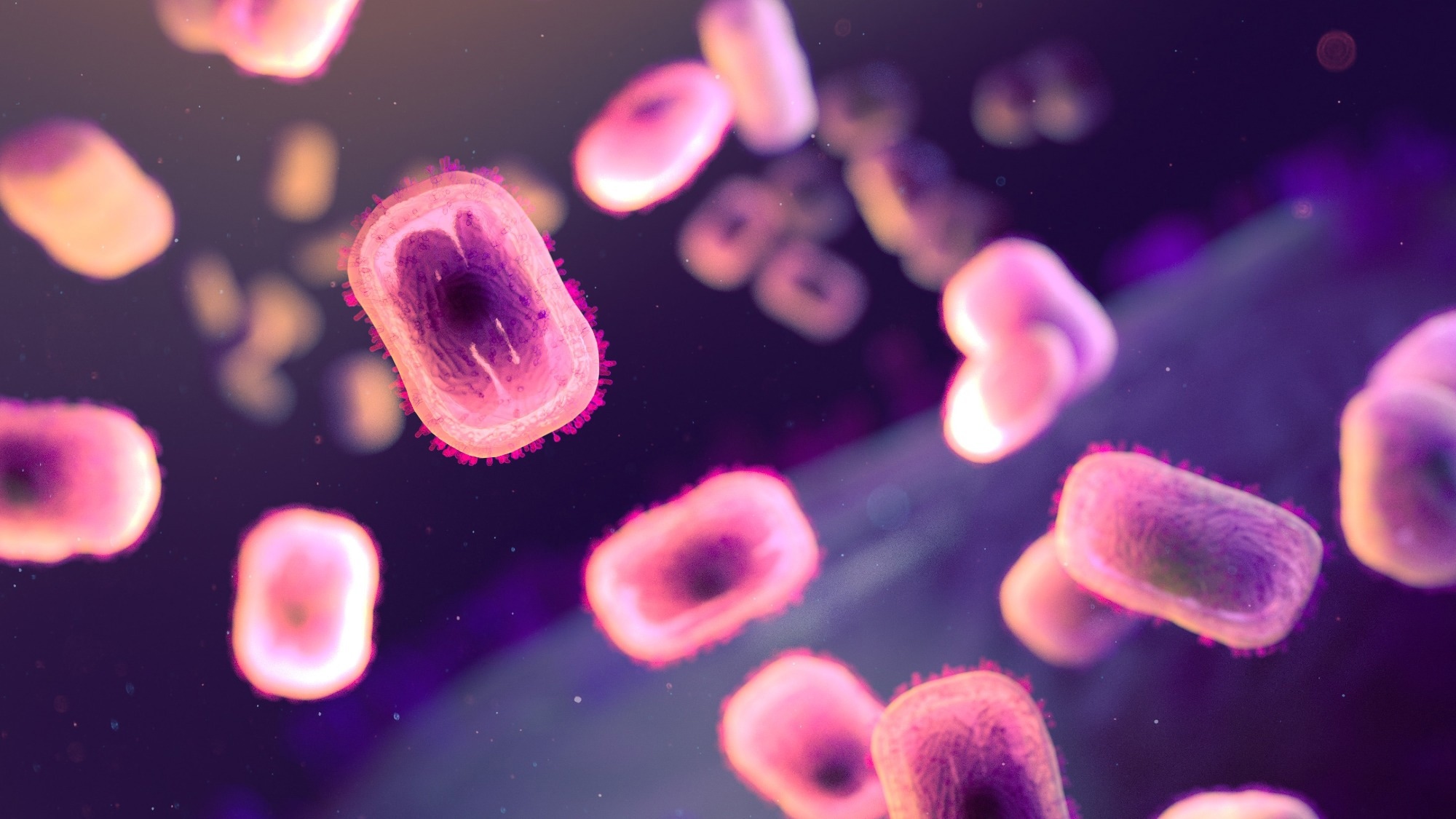A UK hospital study finds infectious MPXV virus lurking on patient room surfaces, raising questions about environmental transmission and the role of cleaning in keeping outbreaks at bay.
 Rapid communication: Air and surface sampling for clade Ib monkeypox virus in United Kingdom hospitals, 2024 to 2025. Image Credit: NIAID.
Rapid communication: Air and surface sampling for clade Ib monkeypox virus in United Kingdom hospitals, 2024 to 2025. Image Credit: NIAID.
A recent Euro Surveillance journal study conducted a survey between 2024 and 2025 to assess air and surface samples for clade Ib MPXV in high-consequence infectious disease centres in the United Kingdom.
Background
Between late October 2024 and the end of January 2025, the first eight patients with MPXV infection symptoms were identified in the UK. Seven of the patients were admitted to airborne high-consequence infectious disease (HCID) centres for monitoring and clinical observation to understand whether they contaminated their immediate environment with MPXV. MPXV was examined using environmental surface and air samples collected from the patients’ rooms or anterooms.
About the study
All seven MPXV patients were below 60 years of age; three were female and four were male. Among these patients, four had a travel history linked to known endemic regions for clade Ib MPXV, while three patients contracted the infection through household transmission within the UK.
Samples of environmental air and surfaces linked to MPXV patients in HCID were collected. Environmental samples were collected on seven separate occasions; five sampling events occurred while rooms were occupied by patients with confirmed clade Ib MPXV infection, and two sampling events were conducted approximately 16 hours post discharge of these patients.
The sampling events were designed such that samples from the same surfaces in all rooms were collected using Copan flocked swabs. Air samples were collected using a Sartorius MD8 Airport from these rooms before and during a bed linen change. Minor variations in sampling events could be attributed to different room set-ups. All samples were assessed using quantitative (q)PCR, and those with detectable MPXV DNA were subjected to virus isolation.
Study findings
Out of 90 surface samples, MPXV DNA was detected in 66 samples. Notably, surface samples collected from frequently touched points exhibited a higher frequency of detectable MPXV DNA. For instance, MPXV was detected in bathroom tap handle samples collected during all seven sampling events. Similarly, detectable MPXV DNA was found in samples collected from the shower handle and toilet flush from six of seven sampling events.
Sampling events performed post patient discharge or concerning those with a severity score of ‘mild’ based on World Health Organization (WHO) guidance, exhibited low levels of MPXV DNA (Cq values of above 32.0). A higher MPXV DNA detection with Cq value ≤32.0 was observed in surface samples from the rooms of patients diagnosed as ‘moderate’ or ‘severe’ infection according to the WHO severity score.
Interestingly, samples collected from the room of Case 6, a patient with moderate MPXV symptoms, showed high Cq values or had no MPXV DNA detected. This could be because the room was cleaned 12 hours prior to sampling, as opposed to 24 hours for the remaining cases.
Out of 21 samples containing detectable MPXV DNA, four samples revealed the presence of infectious virus. These samples were obtained from a tap handle from the ensuite bathroom, a light switch, the anteroom exit, and the window ledge. Viral cultures developed from these four samples revealed undetectable levels of MPXV DNA on day 0 of viral isolation, but Cq values dropped below 23 by day 7–10, confirming active viral replication. The paper notes that daily, thorough cleaning of the rooms, including with 5,000 ppm sodium hypochlorite solutions for high-touch points and floors, may have contributed to this relatively low number of samples with viable virus.
All positive viable viral cultures were from samples collected in isolation rooms with patients classified as having moderate to severe infection, and these samples were collected before patient discharge. Among all air samples, only one, taken during a bed linen change, exhibited detectable MPXV DNA; however, an infection-competent virus was not identified in this sample.
These overall findings are broadly consistent with studies on the clade IIb MPXV strain from the 2022 public health emergency.
Conclusions
The current study revealed that patients infected with clade Ib mpox can contaminate their immediate surroundings with MPXV, including infection-competent virus. While the study cannot accurately quantify the transmission risk from these findings, they underscore the importance of defined infection prevention and control (IPC) measures.
This study has certain limitations, including sampling events being performed in patients’ rooms with varying disease severity, demographic characteristics, and time since onset and hospital admission. Furthermore, two patients shared a room, which may contaminate the room differently than those patients with single occupancy, and two sampling events were performed post-patient discharge.
More research is required to understand how and when MPXV patients contaminate their immediate environment. This information will help determine the risk of mpox infection in both healthcare and non-healthcare settings, such as domestic residence,s where previous studies have shown high levels of contamination, likely due to more porous materials and less frequent, intensive cleaning. It is also important to gain additional data relating to paediatric cases, particularly those with moderate or severe disease. In the future, more studies regarding MPXV transmission and the factors influencing environmental contamination and viral viability are needed to inform proportionate IPC policies and prevent further spread of the infection.
Journal reference:
- Atkinson Barry, Gould Susan, Nicholls Ian, Manzoor Khanzadi Nazneen, Smith Jack, Hindle Andrew J., Tunbridge Anne J., Cole Joby, Collini Paul, Alonso Alejandra, O’Hara Geraldine, Tuudah Cecilia, Otter Jonathan A., Hack Berkin, Taylor Caroline, Pottage Thomas, Fletcher Tom, Dunning Jake. Air and surface sampling for clade Ib monkeypox virus in United Kingdom hospitals, 2024 to 2025. Euro Surveill. 2025;30(19):pii=2500288. DOI: 10.2807/1560-7917.ES.2025.30.19.2500288, https://www.eurosurveillance.org/content/10.2807/1560-7917.ES.2025.30.19.2500288